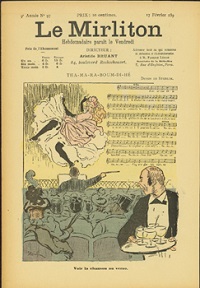Tha-Ma-Ra-Boum-Di-Hé
Women and Entertainment in Paris
February 4–May 31, 2009

Aristide Bruant and Théophile Steinlen
Le Mirliton No. 97
17 February 1893
Paris: Cabinet du Mirliton, 1893
The Robert Sterling Clark Collection of Rare Books, the Clark Art Institute
Toward the end of the nineteenth century, the working-class neighborhoods of Montmartre became a popular meeting spot for a wide spectrum of Parisian society. Cabarets and dance halls such as the legendary Moulin Rouge, Le Chat Noir, and Le Mirliton replaced older, more disreputable bars, bringing with them new forms of often-bawdy entertainment.
Artists such as Henri de Toulouse-Lautrec and Théophile Steinlen were also enjoying the entertainments offered in the saloons and on the streets. They translated their interest from the personal to the professional, capturing the denizens of the area in their artwork. Cancan dancers and prostitutes became their examples of Parisian women. Illustrators and cartoonists likewise turned to the world of entertainment—in all its forms—as a source of commentary and inspiration. The popular press championed these images, further spreading the rambunctious lifestyle of Montmartre across Paris.
All of the works shown are from the Sterling and Francine Clark Art Institute Library. The Clark has rich and deep holdings in illustrated books and periodicals from late-nineteenth-century France, many of which were part of the founder’s collection, the Robert Sterling Clark Collection of Rare Books.
Aristide Bruant, 1851–1925
Théophile Steinlen, 1859–1923, illustrator
Le Mirliton, no. 97, February 17, 1893
Paris, Cabaret du Mirliton, 1893
Bruant was the owner of one of the most popular cabarets on Montmartre. His brusque style, coupled with the site’s lascivious entertainment, made this a meeting place for artists, writers, and workmen, as well as for upper-middle-class Parisians looking for an adventure. Bruant issued a weekly newsletter that noted upcoming artistic events in the area, as well as reproducing sheet music for some of his own songs. Many of the covers were illustrated by Steinlen and capture the character of both the music hall and the street life just outside the doors.